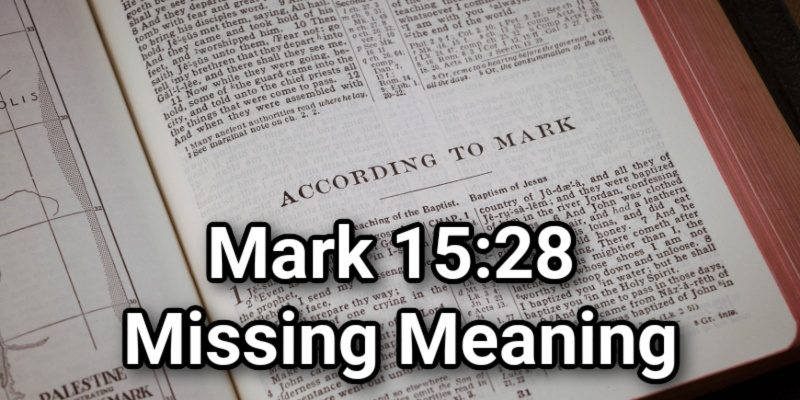Lord’s Library editors offer a Mark 15:28 meaning with commentary on why the verse is missing from new Bible versions, for your edification.
 When trying to understand the meaning of Mark 15:28 and see why it’s missing in modern versions, first see the verse: “And the scripture was fulfilled, which saith, And he was numbered with the transgressors.”
When trying to understand the meaning of Mark 15:28 and see why it’s missing in modern versions, first see the verse: “And the scripture was fulfilled, which saith, And he was numbered with the transgressors.”
Mark 15:28 says, “And the scripture was fulfilled, which saith, And he was numbered with the transgressors.” This verse ties directly into Isaiah 53:12, the towering Old Testament prophecy of the suffering servant who would bear the sins of many. In this single line, the Gospel of Mark affirms that Christ’s crucifixion was not a random execution, but the deliberate fulfillment of Scripture—specifically, that the Messiah would be counted among criminals. It confirms that Jesus was the long-prophesied Savior, fulfilling prophecy down to the detail of who He died next to. Yet, astonishingly, this verse is completely missing from almost all modern Bible versions, including the ESV, NIV, and NASB. They either omit it entirely or relegate it to a footnote with the now-familiar excuse: “some manuscripts do not include this verse.” What they don’t emphasize is that the majority of manuscripts do include it, and that its omission reflects not precision, but a slow, systemic erasure of prophecy-fulfilling, Christ-exalting truth.
Mark 15:28 Missing Meaning
Removing Mark 15:28 is not a neutral act—it is theologically consequential. This verse explicitly links the crucifixion to prophecy. It shouts from the page that Calvary was not a tragedy but a fulfillment. By erasing this verse, modern versions sever the connection between the suffering of Jesus and the plan of God revealed in Isaiah 53. That’s no small loss. It minimizes the prophetic precision of Scripture and weakens the reader’s ability to see how Jesus fulfills the law and the prophets. This isn’t a stray doctrinal aside—it’s the very heart of biblical theology: that Jesus died according to the Scriptures (1 Corinthians 15:3). That He was not caught in the plans of men, but was delivered according to the foreknowledge of God (Acts 2:23). Mark 15:28 cements that understanding by anchoring the moment of Christ’s death to the ancient Word of God. Without it, the prophetic context is blurred, and one more thread tying the Old and New Testaments together is cut.
The omission of Mark 15:28 once again traces back to the same flawed textual foundation: Codex Vaticanus and Codex Sinaiticus, the darling manuscripts of the critical text crowd. These two manuscripts, despite their revered status in academic circles, are riddled with inconsistencies, omissions, and scribal corrections. They are the foundation for the Nestle-Aland Greek text, which underpins nearly every modern translation. That means modern Bibles are consistently built on scarce manuscript support and questionable textual philosophy. The vast majority of Byzantine manuscripts—which the King James translators had access to—include Mark 15:28. So do numerous early citations and translation traditions. In fact, the verse was never questioned until the rise of modern textual criticism in the 19th century. For over 1,700 years of Church history, this verse stood uncontested. Only now, under the gaze of scholars who treat the Bible as a puzzle instead of a preserved revelation, has it been demoted to a footnote.
And ask yourself—why this verse? Why remove a verse that connects the crucifixion directly to fulfilled prophecy? Why remove a line that highlights Jesus’ identity as the suffering servant? The pattern is unmistakable. Verses that exalt Christ, reinforce prophecy, emphasize judgment, or declare absolute truth are repeatedly excised from the modern versions. This isn’t just about manuscripts. It’s about the trajectory of the modern Bible movement: away from reverence, away from continuity, and away from power. The fruit of this movement is a Church that reads a fragmented, neutered Bible and wonders why it has no fire.
Mark 15:28 is preserved in the King James Bible because it belongs there. It was never an addition—it was preserved by the hand of God through the traditional text used and trusted by the believing Church for centuries. The King James doesn’t negotiate with scholars over what Christ did or didn’t fulfill. It proclaims it boldly: “And the scripture was fulfilled, which saith, And he was numbered with the transgressors.” If your Bible won’t say it, get one that will. Stick with the Book that doesn’t flinch when it comes to prophecy, authority, and truth. Stick with the King James Bible.
Lord's Library is a Christian resource hub. Our editors use a variety of internet research methods like search engines, audio and video, AI, consultations with ministry leaders in the field, and more. Lord's Library should never be a substitute for reading your Bible daily as the Scriptures are to be our final authority on all matters. Lord's Library participates in affiliate programs. We may make a small commission from products purchased through this resource.
- Mark 7:16 Meaning: Why is it Missing in Modern Bibles? - June 5, 2025
- What Does the Bible Say about Habits? With Key Scriptures - May 25, 2025
- What Does the Bible Say about Grief? With Key Scriptures - May 24, 2025















